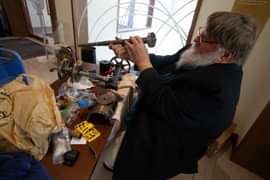
April 21, 2023
A revolutionary American
Pulitzer Prize–winning author Stacy Schiff ’78 Delves Into the Life of Samuel Adamsby Nancy Hitchcock
After tackling such robust topics as Cleopatra, the Salem witch trials, and Benjamin Franklin, Pulitzer Prize–winning author Stacy Schiff has turned her attention to Samuel Adams, a founding father, Revolutionary War leader, and persistent troublemaker for the British authorities. In The Revolutionary: Samuel Adams (Little, Brown, 2022), Schiff explores the mastermind behind the Boston Tea Party who incited the colonists.
What do you most want readers to understand about Samuel Adams?
It’s invigorating to see what one individual—especially one late-blooming individual—can accomplish. As a historian friend put it, Adams’s name shouldn’t be on a beer. It should be on the Revolution. The Revolution looks different when you return Adams to the picture. It’s a less straightforward affair, proceeding by fits and starts, detours and switchbacks, provocations and overreactions. What Adams leads is no less than one of the most successful campaigns of civil resistance in history.
Insofar as we know anything of Adams at all, I think most of us write him off as a firebrand. His cousin John left a different picture, describing Samuel as a man of “refined policy, steadfast integrity, exquisite humanity, genteel erudition, obliging, engaging manners, real as well as professed piety, and a universal good character.” So not exactly the firebrand of legend.
Were you surprised by any of your findings?
I was thunderstruck by the fact that Adams’s contemporaries agree on his primacy—how no one rivals him when it comes to effecting the revolution in thought that produces 1776—and also on how little he’s remembered. Over and over, he locates and dives through loopholes; he’s endlessly resourceful, from the run-up to the Stamp Act through the first meeting of the Continental Congress. Paul Revere’s ride looks different, too, with Adams back in the picture. Few of us stop to wonder, I think, where precisely Revere was headed when he rode off, at high speed, on the night of April 16, 1775. His mission was to warn Samuel Adams, then the most wanted man in America, of imminent arrest.
What was particularly challenging about your research?
John Adams leaves us with a harrowing description of his cousin, Samuel, in Philadelphia at the Continental Congress, feeding his papers to the fire. John asked if he was possibly overreacting. “Whatever becomes of me,” replied Samuel, “my friends shall never suffer for my negligence.” That’s the kind of scene that stops the biographer’s heart; it took me a long time to feel confident that—despite what Samuel Adams burned and what he reduced to confetti—it would be possible to map the contours of his life.
What compelled you to dedicate the book to Nancy Faust Sizer?
Nancy was my History 35 teacher upper year, my house counselor senior year, and—so far as I can remember—the first adult who listened as if what was going to come out of my mouth might actually be worth hearing. She gets some blame too. Along with Phil Zaeder [instructor in English], she suggested I might think about writing as a career!
Who were your other favorite teachers?
Elwyn Sykes, Gil Sewall, and Tom Hodgson. One of Hodgson’s first assignments: on a blank sheet of paper, write down everything in your mind right now. He meant for us to explore the distinction between facts and values, the objective and the subjective. I’ve no idea what I wrote, but I was in heaven.
What is most gratifying about The Revolutionary?
You always hope not only to be true to the history, but also to make an original contribution to literature. And the best thing a writer of nonfiction ever hears is that her book reads like a novel. Funny how no writer of fiction would ever want to hear the opposite!
Other Stories

John Briggs ’77 and the Abbot Academy Fund bring the iconic instrument home

Before becoming a lifelong environmental rights advocate, Jerry Secundy ’59 helped desegregate Harvard



